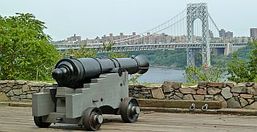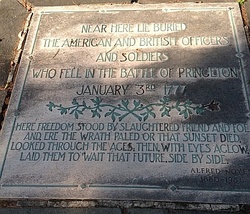* Home
|
-- Battlefields / Military
 Ford Mansion. Image: National Park Service Ford Mansion. Image: National Park Service
After Ford's death in 1777, his widow offered house to Washington as headquarters during winter encampment while she moved into two rooms with her four children. Ford family and descendants continued to live in house until 1870s sale at auction to wealthy residents who formed nonprofit Washington Association of New Jersey to preserve house, later donated house and collections to National Park Service in 1933. House furnished to reflect 1770s, shown in guided tours which begin in museum building. Museum building designed by noted architect John Russell Pope, who also designed Jefferson Memorial in Washington, features exhibits of furniture, weapons, documents and other 18th century objects. Park also includes Wick House built between 1747 and 1750, which served as officers' headquarters of Major Joseph Bloomfield of Third New Jersey Regiment during winter of 1776-1777 and of General Arthur St. Clair in 1779-1780 winter encampment. House open to public, furnished to portray its use as a general's headquarters. Washington also ordered construction nearby of fortifications on hill overlooking Morristown, later known as "Fort Nonsense," also administered by National Park Service and open to visitors.
 Cannon at Fort Lee Historic Park with George Washington Bridge in background. Image: FortWiki.com/John Stanton CC BY SA-4.0 Cannon at Fort Lee Historic Park with George Washington Bridge in background. Image: FortWiki.com/John Stanton CC BY SA-4.0
Fort built commencing July 1776 on bluffs of Palisades at Hudson River on orders of General George Washington intended, along with Fort Washington constructed on New York side of River, to protect lower Hudson from British warships. Originally named Fort Constitution and situated in what was then Hackensack Township at ferry wharf known as Burdett's Landing, renamed Fort Lee after Continental General Charles Lee.  Detail of 1777 map depicting Fort Lee (or Fort Constitution) and Fort Washington. Image: Wikimedia Commons/Boston Public Library Detail of 1777 map depicting Fort Lee (or Fort Constitution) and Fort Washington. Image: Wikimedia Commons/Boston Public Library
After Continental troops were defeated and captured at Fort Washington on November 16, 1776, 5,000 British and Hessian soldiers ferried across River to invade New Jersey, with Washington ordering evacuation of Fort Lee on morning of November 20, retreating southwest to New Brunswick and eventually across Delaware River to winter encampment at Valley Forge. Park operated by Palisades Interstate Park Commission, Visitor Center open Wednesday through Sunday. Situated west of Park is 700-acre Monument Park, dedicated in 1908 by Daughters of the American Revolution, site of original Fort Constitution, only park in nation dedicated to soldiers of American Revolution.
Site of Fort Mercer, built in 1777 on New Jersey shore of Delaware River along with Fort Mifflin on Pennsylvania side, on orders of General George Washington to strengthen defense of Philadelphia. Located in what is now National Park in Gloucester County north of West Deptford. Fort Mercer named in honor of Brigadier General Hugh Mercer who was mortally wounded in January 1777 at Battle of Princeton. Property originally acquired and large brick home built 1748 by James and Ann Whitall, Quakers who established 400-acre plantation with fruit orchards, lumber mill, shad fishery and ferry. On October 22, 1777, 900 Hessian soldiers were repulsed in assault on Fort by 600 soldiers of Continental Army regiment from Rhode Island, with Whitall home serving as field hospital and Ann Whitall nursing soldiers of both sides. Many Hessians remain buried north of home. In next month, Fort Mercer evacuated after loss of Fort Mifflin and landing nearby on November 18, 1777 of 2,000 British troops commanded by Lord Cornwallis followed by British occupation of Philadelphia. Site currently includes 44-acre Gloucester County Park with Whitall House, museum and gardens (open spring to fall), monument, cannons and walking trails. Battle annually re-enacted in October, other special events and demonstrations of colonial cooking, crafts etc. conducted by volunteers.
|







